
To create a simple project – one without metadata, or scaling (geocoding is detected automatically) – go to File > Load Image File in the main menu.
In Windows there is a 260-character limit on filenames and filepaths http://msdn.microsoft.com/en-us/library/windows/desktop/aa365247%28v=vs.85%29.aspx. Trimble software does not have this restriction and can export paths and create workspaces beyond this limitation. For examples of this feature, refer to the FAQs in the Windows installation guide.

Load Image File (along with Open Project, Open Workspace and Load Ruleset) uses a customized dialog box. Selecting a drive displays sub-folders in the adjacent pane; the dialog will display the parent folder and the subfolder.
Clicking on a sub-folder then displays all the recognized file types within it (this is the default).
You can filter file names or file types using the File Name field. To combine different conditions, separate them with a semicolon (for example *.tif; *.las). The File Type drop-down list lets you select from a range of predefined file types.
The buttons at the top of the dialog box let you easily navigate between folders. Pressing the Home button returns you to the root file system.

There are three additional buttons available. The Add to Favorites button on the left lets you add a shortcut to the left-hand pane, which are listed under the Favorites heading. The second button, Restore Layouts, tidies up the display in the dialog box. The third, Search Subfolders, additionally displays the contents of any subfolders within a folder. You can, by holding down Ctrl or Shift, select more than one folder. Files can be sorted by name, size and by date modified.
In the Load Image File dialog box you can:
To later add additional image or thematic layers go to File > Add Data Layer in the main menu.
The Source View dialog provides users a simple data management area to modify input layer alias, display orders and access information on file details.
To open the dialog choose View > Source View.
 Select the Add input layer button to load data files, alternatively you can select the files in the Windows File Explorer and drag and drop them to the dialog to import them. You can add image layers, vector and point cloud layers to a new or existing project.
Select the Add input layer button to load data files, alternatively you can select the files in the Windows File Explorer and drag and drop them to the dialog to import them. You can add image layers, vector and point cloud layers to a new or existing project.
Furthermore, eCognition project (.dpr) and workspace (.dpj) files can be added by drag and drop.
 This button deletes a selected data layer or a whole project (dependent on selection).
This button deletes a selected data layer or a whole project (dependent on selection).
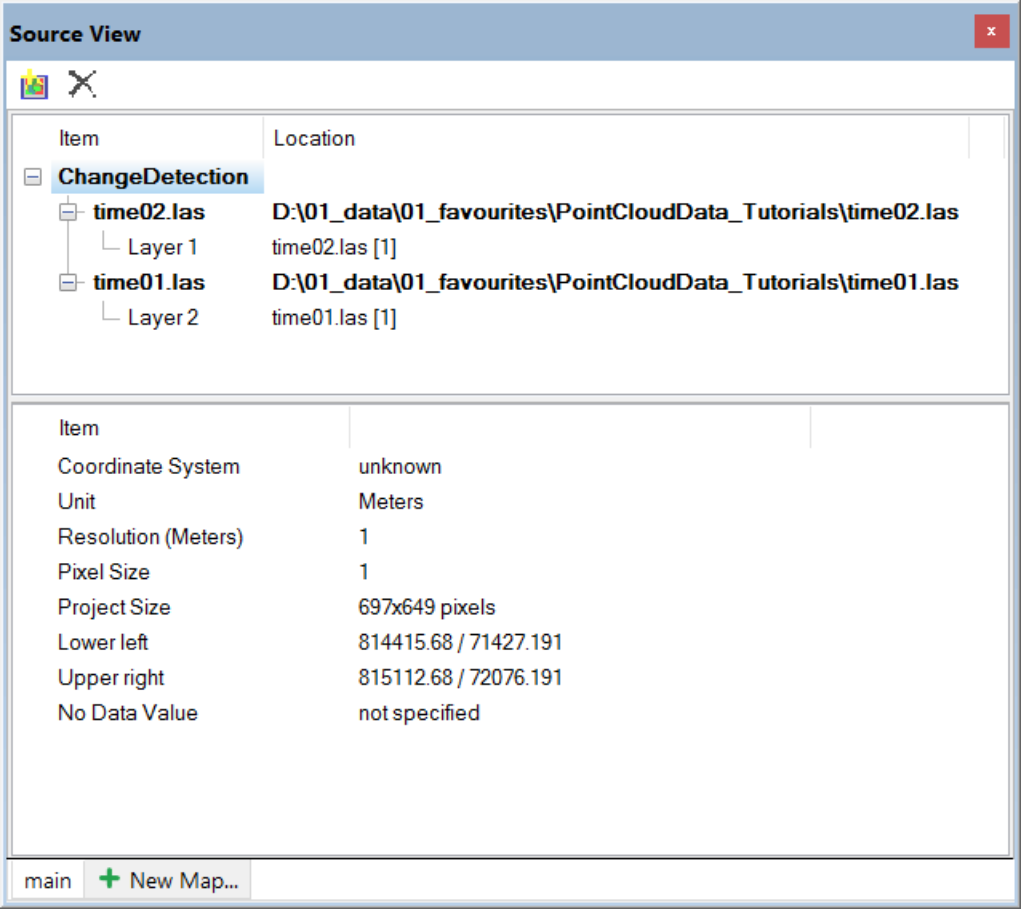
The upper pane of the Source View dialog shows the project name, all data layers loaded, their alias and file paths. On selection of a project file or data file the lower pane shows different details and settings.
If you right click in the upper pane on the project name or a data file you can select one of the following options from the context menu:
The lower pane of the Source View dialog shows the following details
A) on selection of a project:
B) on selection of a data file:
 Use this dialog to add new maps to your project. Once you have added new maps, you can switch between their properties using the tabs at the bottom of the dialog.
Use this dialog to add new maps to your project. Once you have added new maps, you can switch between their properties using the tabs at the bottom of the dialog.
When you create a new project, the software generates a main map representing the image data of a scene. To prepare this, you select image layers and optional data sources like thematic layers or metadata for loading to a new project. You can rearrange the image layers, select a subset of the image or modify the project default settings. In addition, you can add metadata.
An image file contains one or more image layers. For example, an RGB image file contains three image layers, which are displayed through the Red, Green and Blue channels (layers).
Open the Create Project dialog box by going to File > New Project (for more detailed information on creating a project, refer to The Create Project Dialog Box). The Import Image Layers dialog box opens. Select the image data you wish to import, then press the Open button to display the Create Project dialog box.
Opening certain file formats or structures requires you to select the correct driver in the File Type drop-down list.
Then select from the main file in the files area. If you select a repository file (archive file), another Import Image Layers dialog box opens, where you can select from the contained files. Press Open to display the Create Project dialog box.

The Create Project dialog box gives you several options. These options can be edited at any time by selecting File > Modify Open Project:
In special cases you may want to ignore the unit information from the included geocoding information. To do so, deactivate Initialize Unit Conversion from Input File item in Tools > Options in the main menu
Geocoding is the assignment of positioning marks in images by coordinates. In earth sciences, position marks serve as geographic identifiers. But geocoding is helpful for life sciences image analysis too. Typical examples include working with subsets, at multiple magnifications, or with thematic layers for transferring image analysis results.
Typically, available geocoding information is automatically detected: if not, you can enter coordinates manually. Images without geocodes create automatically a virtual coordinate system with a value of 0/0 at the upper left and a unit of 1 pixel. For such images, geocoding represents the pixel coordinates instead of geographic coordinates.
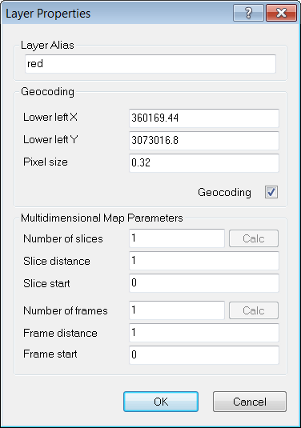
The software cannot reproject image layers or thematic layers. Therefore all image layers must belong to the same coordinate system in order to be read properly. If the coordinate system is supported, geographic coordinates from inserted files are detected automatically. If the information is not included in the image file but is nevertheless available, you can edit it manually.
After importing a layer in the Create New Project or Modify Existing Project dialog boxes, double-click on a layer to open the Layer Properties dialog box. To edit geocoding information, select the Geocoding check box. You can edit the following:
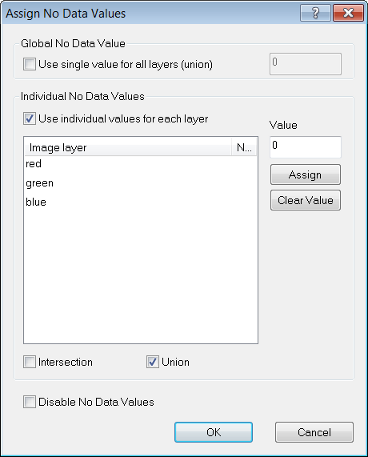
No-data values can be assigned to scenes with two dimensions only. This allows you to set the value of pixels that are not to be analyzed. Only no-data-value definitions can be applied to maps that have not yet been analyzed.
No-data values can be assigned to image pixel values (or combinations of values) to save processing time. These areas will not be included in the image analysis. Typical examples for no-data values are bright or dark background areas. The Assign No Data Value dialog box can be accessed when you create or modify a project.
After preloading image layers press the No Data button. The Assign No Data Values dialog box opens:
You can insert image layers and thematic layers with different resolutions (scales) into a map. They need not have the same number of columns and rows. To combine image layers of different resolutions (scales), the images with the lower resolution – having a larger pixel size – are resampled to the size of the smallest pixel size. If the layers have exactly the same size and geographical position, then geocoding is not necessary for the resampling of images.
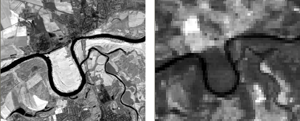
When creating a new map, you can check and edit parameters of multidimensional maps that represent time series. Typically, these parameters are taken automatically from the image data set and this display is for checking only. However in special cases you may want to change the number, the distance and the starting item of frames. The preconditions for amending these values are:
To open the edit multidimensional map parameters, create a new project or add a map to an existing one. After preloading image layers press the Edit button. The Layer Properties dialog box opens.
Editable parameters are listed in the following table - Multidimensional Map Parameters:
| Parameter | Description | Calc button | Default |
|---|---|---|---|
| Number of frames | The number of two-dimensional images each representing a single film picture (frame) of a scene with time dimension. | Click the Calc button to calculate the rounded ratio of width and height of the internal map. | 1 |
| Frame distance | Change the temporal distance between frames. | (no influence) | 1 |
| Frame start | Change the number of the first displayed frame. | (no influence) | 0 |
Confirm with OK and return to the previous dialog box. After the a with a new map has been created or saved, the parameters of multidimensional maps cannot be changed any more.
If the loaded image files are geo-referenced to one single coordinate system, image layers and thematic layers with a different geographical coverage, size, or resolution can be inserted.
This means that image data and thematic data of various origins can be used simultaneously. The different information channels can be brought into a reasonable relationship to each other.

When dealing with Point Cloud processing and analysis, there are several components that provide you with the means to directly load and analyze point clouds, as well as to export result as raster images, such as DSM and DTM.
After loading, the point cloud is displayed in height rendering mode. To allow for quick display of the point cloud a rasterization is implemented in a simple averaging mode based on intensity values. This image layer can be activated in the View Settings dialog (with point cloud inactivated). Complex interpolation of the data can be done based on the Rasterize point cloud algorithm.
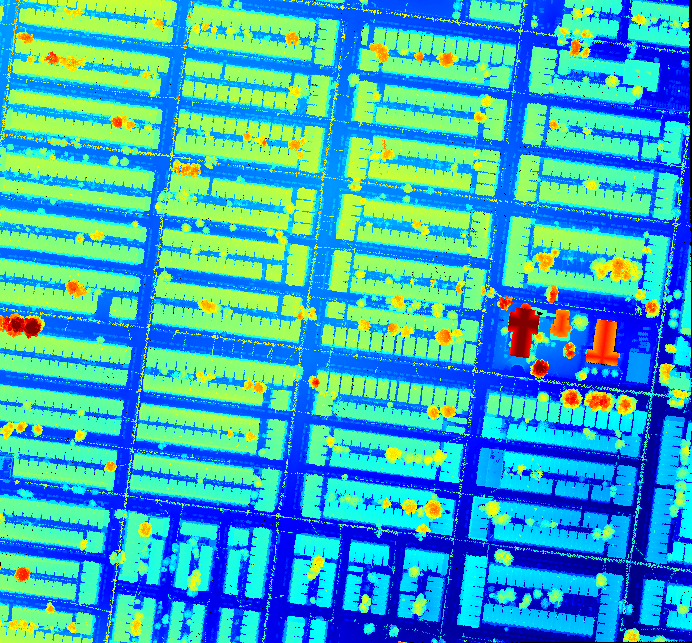
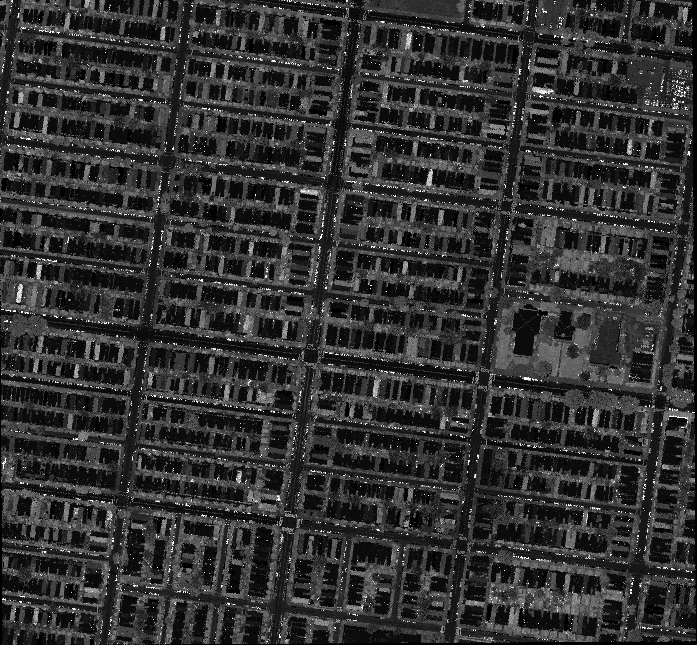

A) Select File > New Project
In the loading process, a resolution must be set that determines the grid spacing of the raster image generated from the las file. The resolution is set to 1 by default, which is the optimal value for point cloud data with a point density of 1pt/m2. For data with a lower resolution, set the value to 2 or above; for higher-resolution data, set it to 0.5 or below.
B) In the View Settings dialog
When working with point clouds, eCognition Developer uses the following approach:
 and draw a rectangle in the view (or alternatively select a non-parallel subset using View > Toolbars > 3D and select the 3 click 3D subset selection button to draw the rectangle).
and draw a rectangle in the view (or alternatively select a non-parallel subset using View > Toolbars > 3D and select the 3 click 3D subset selection button to draw the rectangle).
The Workspace window lets you view and manage all the projects in your workspace, along with other relevant data. You can open it by selecting View > Windows > Workspace from the main menu.
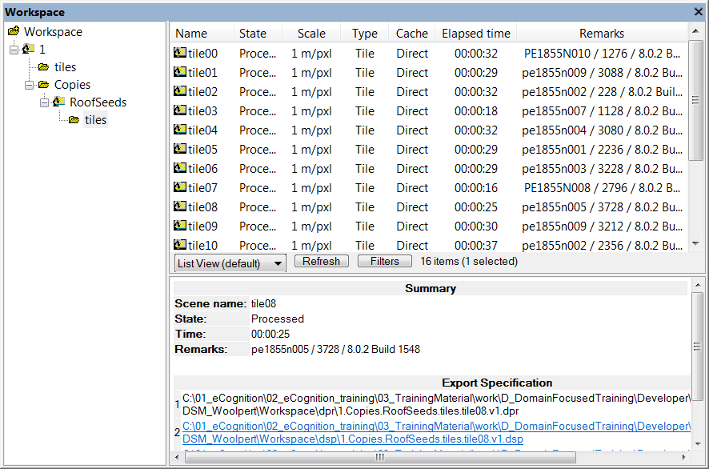
The Workspace window is split in two panes:
In List View and Folder View, information is displayed about a selected project – its state, scale, the time of the last processing and any available comments. The Scale column displays the scale of the scene. Depending on the processed analysis, there are additional columns providing exported result values.
To open a workspace, go to File > Open Workspace in the main menu. Workspaces have the .dpj extension. This function uses the same customized dialog as described for loading an image file (Creating a Simple Project).
Alternatively you can select workspace (.dpj) or project (.dpr) files in the Windows File Explorer and drag and drop them to the workspace window to import them.
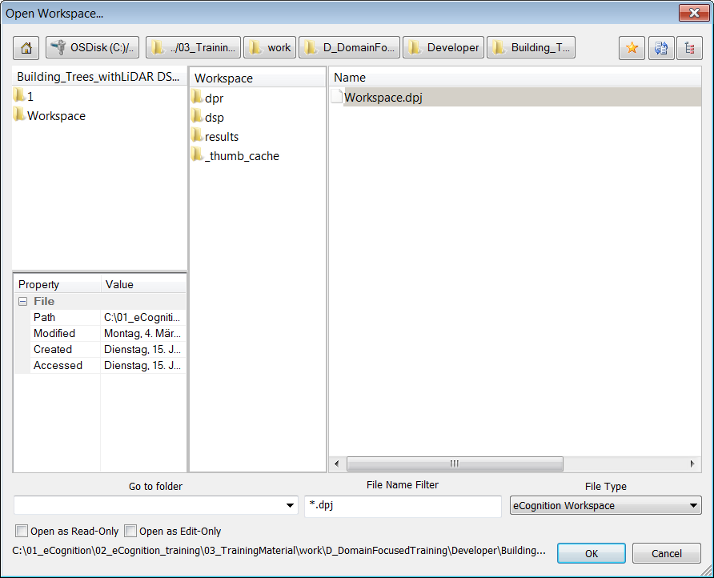
To create a new workspace, select File > New Workspace from the main menu or use the Create New Workspace button on the default toolbar. The Create New Workspace dialog box lets you name your workspace and define its file location – it will then be displayed as the root folder in the Workspace window.
If you need to define another output root folder, it is preferable to do so before you load scenes into the workspace. However, you can modify the path of the output root folder later on using File > Workspace Properties.
The two checkboxes at the bottom left of the Open Workspace dialog box determine the permissions of the user who opens it.
If a Project Edit user opens a workspace before a full user, the Workspace view will display the status ‘locked’. Users can use the Project History function to show all modifications made by other users.
Multiple access is not possible in Data Management mode. If a workspace is opened using an older software version, it cannot be opened with eCognition Developer at the same time.
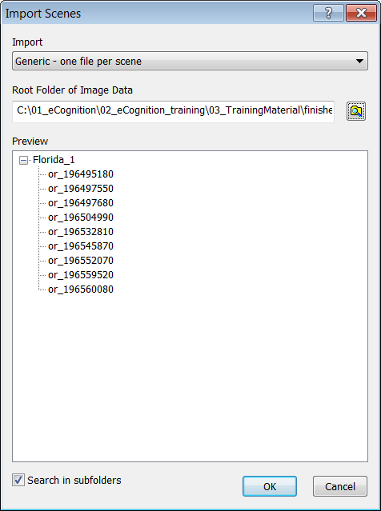
Before you can start working on data, you must import scenes in order to add image data to the workspace. During import, a project is created for each scene. You can select different predefined import templates according to the image acquisition facility producing your image data.
If you only want to import a single scene into a workspace, use the Add Project command. To import scenes to a workspace, choose File > Predefined Import from the main menu or right-click the left-hand pane of the Workspace window and choose Predefined Import. (By default, the connectors for predefined import are stored in the installation folder under \bin\drivers\import. If you want to use a different storage folder, you can change this setting under Tools > Options > General.)
The Import Scenes dialog box opens:
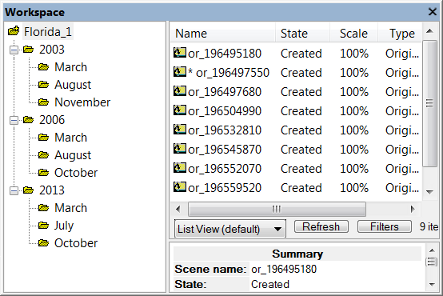
| Import Template (Connector) | Description | File Formats | File Based? | Windows | Linux |
|---|---|---|---|---|---|
| Generic – one file per scene | A scene may consist of multiple image layers. All image layers are saved to one file | All | Yes | Yes | Yes |
| Generic – one scene per folder | All files that are found in a folder will be loaded to one scene | All | Yes | Yes | Yes |
Generic import templates may support additional instruments or image readers not listed here. For more information about unlisted import templates contact Trimble via www.ecognition.com/support
Image files are scanned into a workspace with a specific method, using import templates, and in a specific order according to folder hierarchy. This section lists principles of basic import templates used for importing scenes within the Import Scenes dialog box.
Images are scanned in a specific order in the preview or workspace. There are two options:
[selected folder] > [1] > [5] > 1.tif & 8.tif[selected folder] > [1] > [8] > 5.tif[selected folder] > [1] > 3.tif & 7.tif[selected folder] > [3] > 6.tif[selected folder] > 2.tif & 4.tif
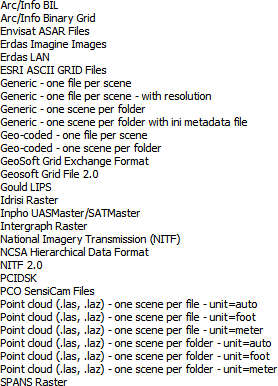
eCognition Developer offers several options for customizing the Workspace.

To select what information is displayed in columns, right-click in the pane to display the context menu.
